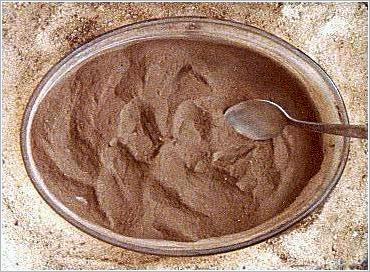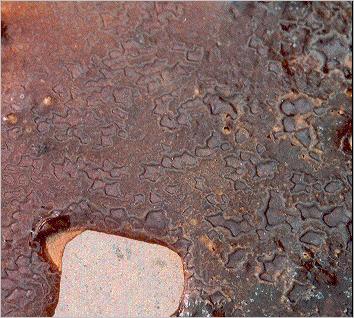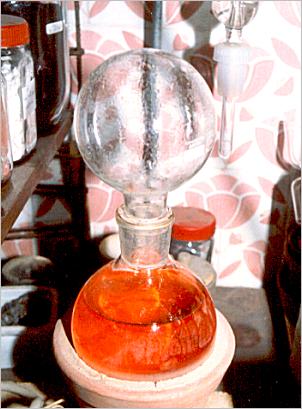Oil of Antimony
In the book The Triumphal Chariot of Antimony, Retz,
Paris, Basil Valentine describes some antimony preparations, among them antimony oil. The
goal of this work is the preparation of the Fiery Stone.
The first operation in the extraction of antimony oil is to grind, in a
mortar of bronze or iron, at least one or two kilos of good quality stibnite.
After it is reduced to a thin powder, pass it through a 60 lines per
cm. sieve. Pour the reduced mineral into a Pyrex glass container and place it over a wide
mouthed as stove in a sand bath to calcine it. This calcination is for the removal of the
chemical sulphur of antimony and will have to be done carefully with a regulated fire. Mix
it frequently with a with long handled stainless steel spoon as in the image. If you do
not mix the matter frequently, mineral accumulations with sulphur will form, and you will
have to grind and calcinate the matter again.
When properly calcined, the antimony will have a reddish-brown colour
and it will not have the characteristic smell of chemical sulphur. It is a slow operation
that requires much patience to be completed properly. This calcination is the basis of the
whole work therefore you shouldn't be hasty while performing this part of the
operation.

Next, with this powdered antimony (well calcined as the Art demands)
you will proceed in the preparation of the antimony glass. Basil Valentine in the
antecedent texts, states that it is necessary to add borax to the powdered calcined
antimony.
We never followed this process and used only antimony, without
additional substances, as he relates in the following text. We saw it done this way in the
Solazaref Filiation and in Portugal several times it was made this way as well.
Pour into a good crucible of average size antimony duly calcined until
filled, and then place the cover on the crucible. Place it in a gas oven on a refractory
tile, setting it such that the flame of the blowpipe is in the centre of the crucible.
From time to time, with tongs, remove the crucible cover and verify
that the antimony is melting. When it is completely melted, with suitable tongs, take off
the cover and hold the crucible in the middle, removing it from oven.
Carefully, pour out the crucible's contents onto a copper plate or
a marble slab. After it is cooled, the glass can easily be freed from the copper plate or
the marble slab in the form of small plates, which you will break into small pieces that
you will keep in a wide mouthed glass flask.

The true colour of canonical antimony glass (made without borax
addition) is reddish brown, coloured with small dark spots as you see in the image.
Placing one of these plates in front of a source of strong light (such as the Sun) it is
red and transparent.

To prepare antimony oil it is necessary to grind the glass in an iron
or bronze mortar taking care to wear a suitable mask (respirator) to filter the thin dust
that emanates from the mortar. After grinding it is necessary to pass it through a sieve
of at least 60 lines per cm.
Let us see now, what Basil Valentine says on pg. 170, Chapter VII, on
the Way To Make Antimony Oil:
"Take Glass of Antimony; as it is made of the Minera of Antimony,
subtily pulverized, and extract its Tincture with distilled Vinegar; afterward abstract
the Vinegar thence and edulcorate the remaining Powder. Then pour on Spirit of Wine with
which extract the Tincture, and circulate it in a Pelican well closed, for an entire
Month. Afterward, distil it per se, without any Addition, with a certain singular
Dexterity; and you will thence receive a wonderful grateful and sweet Medicine, in the
form of a Red Oil, of which after may be formed the Stone of Fire.
This Oil is the Quintessence, and the highest, that can be written of
Antimony; as you may find in my former Writings, wherein have made a short Declaration of
Antimony, and in which I showed also, that there are four Instruments required for its
Preparation, and the fifth is that, in which Vulcan hath fixed his Residence."
This text describes, in suitable spagyric language of that time, how
antimony oil is prepared from its glass.
The first operation is to dissolve the ground antimony glass in "strong vinegar" (we understand that to mean the spirit of wine vinegar rectified to 10% Baume). Although this operation seems easy, it is necessary to know the "touch
of hand (have the touch - gained by experience)" to make it efficiently.
Next, you will have to use a circulator made with a 2-litre conic or
spherical balloon and another one of 500ml. as you see in the image.

Pour part of the powdered antimony glass into the balloon, and pour
onto this the strong vinegar. Place the circulator in an electric oven with a temperature
of about 60°C. Shake circularly the lower balloon for the glass powder to mix well with
the spirit of vinegar.
To facilitate the antimony glass dissolution in the spirit of vinegar,
shake the circulator several times per day. When the dissolution is saturated and of a red
colour, shake the lower balloon and remove the upper. Pour the solution into a wide
mouthed bottle using a funnel with a filter. The un-dissolved antimony glass powder will
remain in the filter. Keep the red liquid in a dark glass bottle.
Remove the filter with the glass powder and dry it in a porcelain
container kept at a temperature of 60°C. Pour this glass powder into the circulator and
pour on more spirit of vinegar. Dissolve again as before.
Repeat the same operation, but do not keep the vinegar as before if it
has no dark red colour. In this case, remove the glass powder that you have separated, and
add another recently made antimony glass powder to it.
Continue with the same operation until you have removed the whole
tincture from all of the prepared antimony glass.
Following this, pour the whole of your provision of dyed vinegar into
an alembic, and distil it with a fire suitable for the distillation of vinegar. Be careful
when the distillation approaches the end. Remove the caput of the alembic with a wooden
spoon and dry it slowly in a porcelain container between 40-60°C to remove the whole
acrimony.
When the powder (that is an acetate) is dry, place it in a circulator
(pelican) and pour on spirit of wine " sovereign " distilled about 98%. Leave it
to circulate at least one month as the Master relates in the text.
After the circulation, the Master tells us: "... after that time
you will distil purely and simply without any addition. And for this simple distillation
you will have a sweet medicine, pleasant and admirable in form of beautiful oil and red
with which if it prepares the Fire Rock. "
Basil Valentine was not very explicit in this part of the text, and
leads us to understand that after this last distillation, in the end, it will leave for
the alembic beak " a sweet and pleasant medicine ".
The antimony tincture, after being circulated with the spirit of wine
is toxic - and only will lose this toxicity after passing through the beak of the alembic.
Unhappily, because of reasons that opposed our desires, we could not
make this last distillation and, therefore, we will not be able to confirm the end result
of this operation. We will make it when we have the suitable conditions to prepare the
necessary antimony glass, and the lab conditions to work in the dry way.
However, the main operations are described here as we completed them,
as well as the respective modus operandi with the images, for those who have the suitable
laboratory conditions to make it.
Rubellus Petrinus
@nifo@innergarden.org
Inner Garden Foundation
P.O. Box 8520, 3542AD
Utrecht, The Netherlands